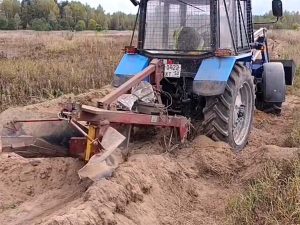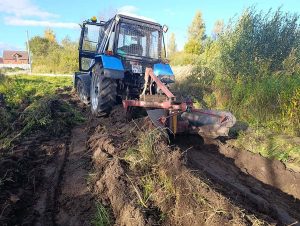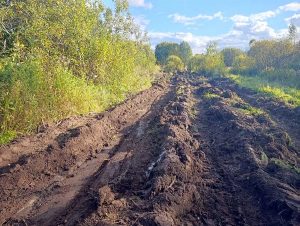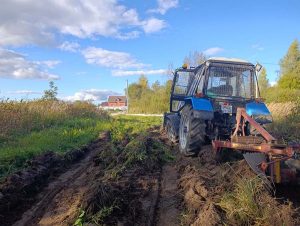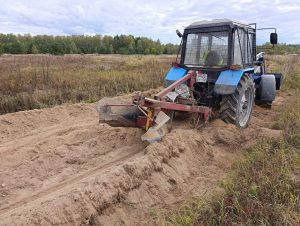Purpose of firebreak plowing
The primary purpose of firebreak plowing is to disrupt the continuity of combustible vegetation cover. Fire spreads rapidly through dry grass and shrubs, but upon reaching a plowed mineral strip it loses intensity and stops. Therefore, plowing around villages and settlements is a critical component of wildfire prevention measures in rural areas.
These works are particularly relevant in spring and summer, when the risk of ignition increases. During this period, dry vegetation in fields and meadows poses a serious wildfire hazard, and only timely established firebreaks can ensure the fire safety of settlements.
Equipment and techniques for creating mineralized strips
Firebreak plowing is typically performed with an MTZ (Belarus) medium-class tractor, well-known for its maintainability, maneuverability, and low operating costs. In confined conditions, a Kubota 7001 micro-tractor with a small forestry plow may be used.
The specialized forestry plow, capable of cutting through shrub and tree roots, enables the quick formation of even, mineralized strips of the required width. Depending on local conditions, the depth and width of the plowing can be adjusted to maximize efficiency. Firefighting plow is a special plow to cut roots of small trees and bushes. It is durable and strong. This model of firefigting plow on fotos costs about $4000.
Work is carried out along the boundaries of forest tracts, meadows, and agricultural lands. Thus, a clear protective firebreak contour is created around a village or settlement, serving as an artificial barrier against fire spread.
Roadside firebreak plowing is also widely applied, since a cigarette butt discarded into dry grass is one of the most frequent causes of fire ignition. In such cases, roadside mowing may also be carried out as a more economical preventive measure.
Firebreak plowing for municipal and industrial facilities
Firebreak plowing of settlements is not only a technical measure but also a key element of public safety. Timely creation of mineralized firebreaks significantly reduces the risk of emergencies and minimizes potential damage to residential houses and infrastructure. For municipal and utility services, firebreak plowing is an obligatory component of fire protection plans, especially in regions subject to droughts and frequent wildfires.
Properly executed strips are convenient for monitoring and further maintenance of the territory: they can be used as access roads for fire engines or as patrol routes for forest–settlement border inspections. Naturally, such strips are also established under power transmission lines (PTL), along gas pipeline corridors, and other utility lines requiring regular maintenance.
Firebreak plowing around villages and settlements is a proven and reliable method of protecting people, property, and natural resources from fire. It requires specialized equipment, strict adherence to technology, and a systematic approach. A systematic approach means periodic inspection and maintenance so that plowed strips do not become overgrown with grass and shrubs again.
Professional services in firebreak plowing
We provide professional firebreak plowing for settlements within the agreed time frame. Contract-based service, non-cash payments available. The offer is relevant for municipal, utility, and industrial organizations.
We ensure high-quality creation of mineralized firebreak strips for wildfire protection. The cost of mineralized strips is determined by the technical specifications and the contract.
Firebreak plowing of settlements, village firebreak plowing, wildfire prevention plowing, MTZ tractor firebreak plowing, plowing with forestry plow, mineralized firebreak strips, wildfire safety measures in rural areas, forest firebreak services, utility firebreak services – contact us!
